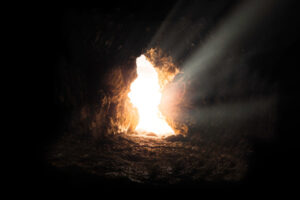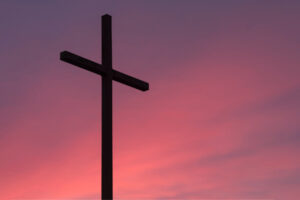A look at the fun traditions in the Pacific, Africa, Asia, Europe and the Americas.
Because Jesus defeated death, we can have hope in this life and in eternity.
As a kid, I remember being excited for Easter service. Not because I necessarily understood the full meaning of Jesus’ resurrection though; it was because Easter was when I’d get to wear a bright yellow dress with a crinoline skirt and a cute white hat with a sort-of-uncomfortable elastic band that hooked under my chin. I loved Easter growing up because it always meant that after church, I’d go to one of my grandparents’ houses for an egg hunt, delicious food and my nana’s traditional Italian Easter cookies.
As I’ve aged, my Easters have changed (alas, I no longer wear bonnets) and that’s a good thing. While I still dress up and go to church with my family, today I celebrate the holiday not for the candy or brunch but with an understanding of the significance Jesus’ resurrection has on my faith.
 Because Jesus defeated death, we can have hope in this life and in eternity. And while your Easter may contain egg hunts, church services and chocolate candy, Christians around the world often celebrate Easter differently. Learn about how people in each region of the world commemorate this important holiday!
Because Jesus defeated death, we can have hope in this life and in eternity. And while your Easter may contain egg hunts, church services and chocolate candy, Christians around the world often celebrate Easter differently. Learn about how people in each region of the world commemorate this important holiday!
PACIFIC
The Pacific is home to thousands of islands with a variety of landscapes. You’re probably familiar with countries in the Pacific like Australia and New Zealand. And since they’re both in the Southern Hemisphere, Easter actually occurs during the fall instead of springtime there. And a lot of New Zealand residents (who are called “Kiwis”) enjoy eating hot cross buns during Easter.
(And yes, hot cross buns are a real food and not just a song you learned how to play on the recorder in elementary school.)
 While we typically associate Easter with images of rabbits in the U.S., some Australians don’t use rabbits for their Easter festivities because they’re considered to be pests. Instead they use the holiday to celebrate an endangered Australian animal called a bilby. It has long ears and looks similar to a rabbit so they dub the animal the “Easter Bilby.”
While we typically associate Easter with images of rabbits in the U.S., some Australians don’t use rabbits for their Easter festivities because they’re considered to be pests. Instead they use the holiday to celebrate an endangered Australian animal called a bilby. It has long ears and looks similar to a rabbit so they dub the animal the “Easter Bilby.”
Easter week is full of church activities in Vanuatu which is an archipelago located in the South Pacific. These activities include a sunrise service on Easter morning and the observance of Good Friday and Easter Monday as official holidays.
AFRICA
Easter is widely celebrated in churches throughout Africa from the Thursday before Easter (called “Maundy Thursday”) through Easter Sunday. Churches are often decorated with cloths that have butterflies, flowers and more on them. Church services are the most crucial parts of Easter throughout the region, and people attend Easter vigils to celebrate the resurrection of Jesus.|
The night before Easter, Christians have a vigil that begins somber; but when morning comes, dancing and music breaks out.
In Ethiopia, Christian churches celebrate Faskia, which is the 55 days leading up to Easter. Faskia is actually a bigger deal to people than Christmas, and that’s why it’s celebrated longer than our Easter in the U.S. During this holiday, people spend 55 days fasting from meat and animal products.
The night before Easter, Christians have a vigil that begins somber; but when morning comes, dancing and music breaks out. Families and communities spend Easter Sunday at church services and in homes, eating and celebrating.
In South Africa, the day after Easter was officially recognized as “Family Day” in the 1990s. Originally the holiday was called “Easter Monday” and was designed for people to recover from the Easter weekend’s festivities. Today the holiday gives families the chance to spend time together.
ASIA
Asia is the largest continent on Earth, and contains a vast number of people groups, cultures and traditions.
Easter is a major religious holiday in the Philippines, which is home to more than 7,000 islands! In this country, two processions happen during Easter — the men are in one procession and follow an image of Jesus risen from the dead while the women make up another procession and follow Jesus’ mother, Mary, who’s wearing a black veil. The two groups meet at the church as a symbol of Jesus comforting Mary after he was raised from the dead. Then girls who are dressed up as angels for Easter take off Mary’s veil (called a lambong) and people celebrate!
 Not all countries throughout Asia celebrate Easter, a traditionally Christian holiday. But even though a small percentage of people in India are Christians, many people celebrate the holiday as a “spring festival.” Egg dyeing and decorating isn’t really celebrated in India but since people are still aware of the longstanding tradition, many purchase elaborately decorated eggs and give them as presents to their children.
Not all countries throughout Asia celebrate Easter, a traditionally Christian holiday. But even though a small percentage of people in India are Christians, many people celebrate the holiday as a “spring festival.” Egg dyeing and decorating isn’t really celebrated in India but since people are still aware of the longstanding tradition, many purchase elaborately decorated eggs and give them as presents to their children.
EUROPE
In Orthodox countries throughout Eastern Europe like Romania, Serbia, Greece and more, Easter is celebrated about 1-2 weeks after other countries because the Orthodox churches in these countries follow the Julian Calendar.
People in Germany love decorating for Easter! They even decorate tree branches for Easter with painted eggs in the same way that people decorate tree branches in December for Christmas. In addition to celebrating the holiday itself, Easter marks the kickoff of spring! Many people wear colorful traditional dress to celebrate the occasion.
 In Poland, families get together to celebrate the holiday and eat a filling Easter Sunday breakfast. But the most famous part of a Polish Easter is the babka, a bread that traditionally has raisins and a thin glaze on top of it.
In Poland, families get together to celebrate the holiday and eat a filling Easter Sunday breakfast. But the most famous part of a Polish Easter is the babka, a bread that traditionally has raisins and a thin glaze on top of it.
On Easter Monday in France, something unique happens. Volunteers in the French town of Bessières gather to cook a giant omelet. Thousands of eggs are cracked and cooked to create this huge dish. So why in the world do they do this?
Well, tradition says that Napoleon and his army were traveling through the south of France one day and stopped in this small town. They ate omelets there, and Napoleon liked them so much that he ordered the townspeople to gather their eggs and make a giant omelet for his army the next day.
And fun fact: The town has been doing this holiday tradition since 1973!
AMERICAS
Since the Americas contain North, South and Central America, there are a lot of different Easter traditions and celebrations.
In Bermuda, people like to fly kites on Good Friday. The tradition started one year when a teacher wanted to help his students learn about Jesus ascending to heaven. So he took a kite decorated with Jesus’ face on it, and let it soar into the sky. It was like Jesus ascending!
In Colombia, Easter Sunday itself isn’t celebrated with lots of fanfare. But Holy Week is celebrated widely throughout the country, with many people having off work part of the week or the entire week! Many people go on vacation during Holy Week, while some travel from bigger cities to smaller Colombian towns for traditional Holy Week processions and to observe decorations in churches.
 And of course, in the United States, Easter is traditionally celebrated with church service, plastic egg hunts, dyeing real eggs and eating lots of sweets. Like… a lot of sweets. Americans actually spent $2.6 billion on candy in 2018 according to the National Retail Federation. We certainly love our sugar, don’t we?
And of course, in the United States, Easter is traditionally celebrated with church service, plastic egg hunts, dyeing real eggs and eating lots of sweets. Like… a lot of sweets. Americans actually spent $2.6 billion on candy in 2018 according to the National Retail Federation. We certainly love our sugar, don’t we?
We’ve visited many countries in this blog, but you might not know that there are people groups in each area of the world that don’t have God’s Word in a language and format they clearly understand yet. That means they don’t know the story of Jesus’ resurrection yet. That’s why Wycliffe exists: to help speakers of the remaining languages get the Bible for themselves.
So whether you’re celebrating Easter by attending a sunrise church service in the U.S., eating a traditional breakfast in Europe or fasting from animal products in Africa, may we all take the time this season to remember the significance of 1 Peter 1:3-4a:
“All praise to God, the Father of our Lord Jesus Christ. It is by his great mercy that we have been born again, because God raised Jesus Christ from the dead. Now we live with great expectation, and we have a priceless inheritance …” (NLT).
This content is adapted from our fun family activity, “Easter Around the World With Kate & Mack.” You can download that PDF for recipes, family discussion questions and more here!

